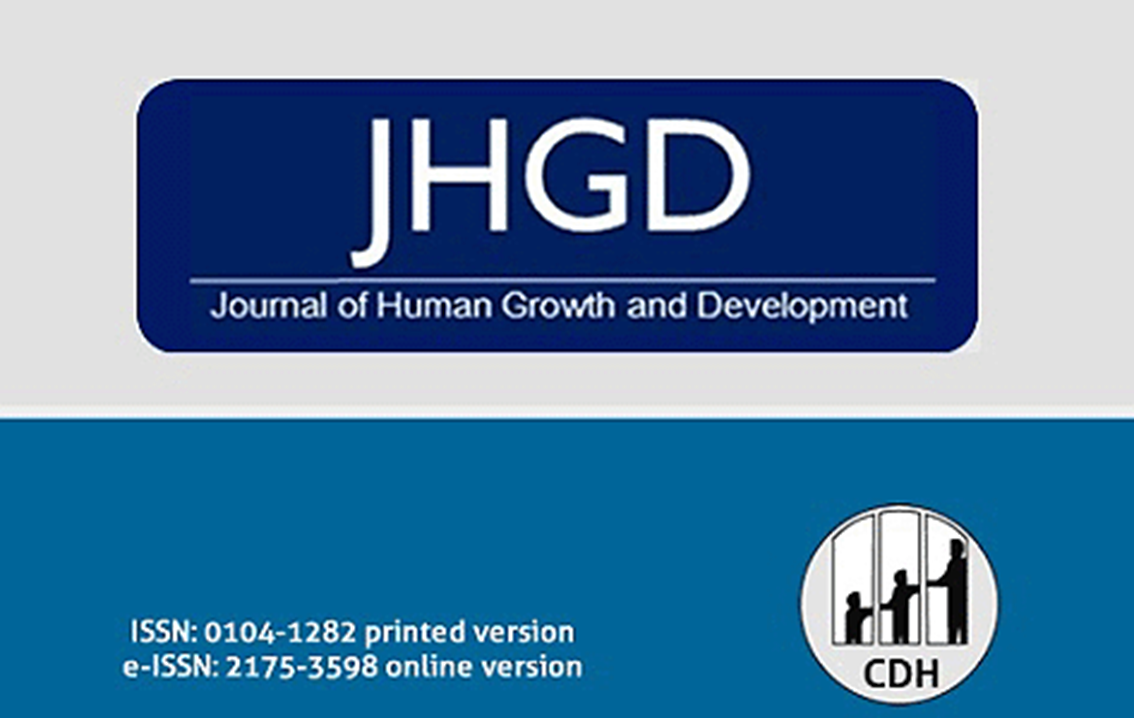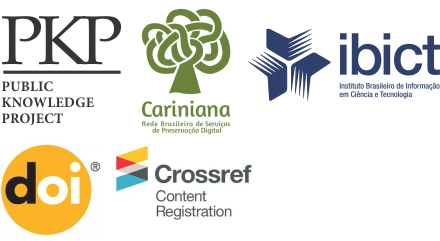Evaluation of growth and nutritional condition of children in Public Schools in Florianópolis, Santa Catarina, Brazil
DOI:
https://doi.org/10.7322/jhgd.v30.9960Keywords:
Nutritional Status, Sex, Body Mass IndexAbstract
Introduction: Obesity is becoming more and more frequent in children, which can result in health problems both in childhood and in adulthood. Considering that, at school age, eating habits may be influenced by the context in which the child is inserted, mainly, lifestyle, inside and outside the school environment, it is important to evaluate the growth achieved in height, as well as their nutritional status, since this can be an indication of future and possible nutritional disorders, allowing to direct resources and effective public policies in this age group.
Objective: Evaluate the growth in stature and nutritional condition of schoolchildren by gender and age in Florianopolis, Santa Catarina, Brazil, in the first semester of the 2012 school year.
Methods: A cross-sectional study was conducted with 595 children of six to ten years of age, through the marketing of Public Municipal Elementary Schools, in the city of Florianópolis, State of Santa Catarina, Brazil. The statistical analysis of the data was performed with the Statistical Package for the Social Science, version 20.0.
Results: It was assessed a larger proportion of children between seven and nine years of age, and both in relation to the stature as the Body Mass Index (BMI). The medians are higher when compared to the reference (World Health Organization), revealing that the children are growing well, even above the average for the benchmark. However, at the same time, they have a BMI higher than expected, even considering their high stature. The diagnosis of nutritional status among the boys and girls showed no statistical differences. However, it is worth highlighting that, although the bigger prevalence is eutrophic children (70.3%), a high prevalence of excess weight (overweight, obesity and severe obesity) can also be observed, around 28% of the sample.
Conclusions: Although most children were found to be in normal nutritional condition, some were identified as being overweight or obese. It was evident that nutritional condition does not differ in relation to gender, but is influenced by age and height.
Downloads
References
2. Barbosa RMS, Croccia C, Carvalho CGN, Franco VC, Salles-Costa R, Soares EA. Consumo alimentar de crianças com base na pirâmide alimentar Brasileira infantil. Rev Nutr. 2005;18(5):633-41. DOI: http://dx.doi.org/10.1590/S1415-52732005000500006
3. Levy RB, Castro IRR, Cardoso LO, Tavares LF, Sardinha LMV, Gomes FS, et al. Consumo e comportamento alimentar entre adolescentes brasileiros: Pesquisa Nacional de Saúde do Escolar (PeNSE), 2009. Cienc Saude Coletiva. 2010;15(Supl 2):3085-97. DOI: http://dx.doi.org/10.1590/S1413-81232010000800013
4. Wang Y, Monteiro C, Popkin BM. Trends of obesity and underweight in older children and adolescents in the United States, Brazil, China, and Russia. Am J Clin Nutr. 2002;75(6):971-7. DOI: http://dx.doi.org/10.1093/ajcn/75.6.971
5. Brasil. Ministério da Saude. Secretaria de Atenção à Saúde. Departamento de atenção Básica. Orientações para a coleta e análise de dados antropométricos em serviços de saúde: Norma Técnica do Sistema de Vigilância Alimentar e Nutricional (SISVAN). Brasília: Ministério da Saúde, 2011.
6. Monteiro CA, Benicio MHA, Konno SC, Silva ACF, Lima ALL, Conde WL. Causas do declínio da desnutrição infantil no Brasil, 1996-2007. Rev Saude Publica. 2009; 43(1):35-43. DOI: http://dx.doi.org/10.1590/S0034-89102009000100005
7. Nascimento VG, Schoeps DO, Souza SB, Souza JMP, Leone C. Risco de sobrepeso e excesso de peso em crianças de pré-escolas privadas e filantrópicas. Rev Assoc Med Bras. 2011;57(6):657-61. DOI: http://dx.doi.org/10.1590/S0104-42302011000600012
8. Costa RF, Cintra IP, Fisberg M. Prevalence of overweight and obesity in school children of Santos city, Brazil. Arq Bras Endocrinol Metabol. 2006;50(1):60-7. DOI: http://dx.doi.org/10.1590/s0004-27302006000100009
9. Salvador CCZ, Kitoko PM, Gambardella AMD. Estado nutricional de crianças e adolescentes: fatores associados ao excesso de peso e acúmulo de gordura. J Hum Growth Dev. 2014;24(3):313-9. DOI: http://dx.doi.org/10.7322/jhdg.88969
10. Tagliari IA, Ferreira MBR, Silva LR, Pizzi J, Leite N. Overweight and low height in children of urban, rural and indigenous communities. J Hum Growth Dev. 2016;26(1)67-73. DOI: https://doi.org/10.7322/jhgd.113723
11. World Health Organization (WHO). Adolescents. In: Physical status: the use and interpretation of anthropometry. Geneva: WHO, 1995; p.263-311.
12. Alves KP, Jaime PC. The national food and nutrition policy and its dialogue with the national food and nutrition security policy. Cienc Saude Coletiva. 2014;19(11):4331–40. DOI: https://doi.org/10.1590/1413-812320141911.08072014
13. Toschke AM, Kohl L, Mansmann U, von Kries R. Meta-analysis of blood pressure tracking from childhood to adulthood and implications for the design of intervention trials. Acta Paediatr. 2010;99(1):24-9. DOI: https://doi.org/10.1111/j.1651-2227.2009.01544.x
14. Bertotto ML, Valmórbida J, Broilo MC, Campagnolo PB, Vitolo MR. Associação entre ganho de peso no primeiro ano de vida com excesso de peso e adiposidade abdominal na idade pré-escolar. Rev Paul Pediatr. 2012;30(4):507-12. DOI: http://dx.doi.org/10.1590/S0103-05822012000400008
15. Silveira JAC, Taddei JAAC, Guerra PH, Nobre MRC. Effectiveness of school-based nutrition education interventions to prevent and reduce excessive weight gain in children and adolescents: a systematic review. J Pediatr (Rio J). 2011;87(5):382-92. DOI: http://dx.doi.org/10.1590/S0021-75572011000500004
16. Nobre GC, Lima KSC, Silva ADG, Souza Filho AN, Letieri RV, Bandeira PFR. Índices de crescimento estatural e estado nutricional de escolares de 6 a 14 anos escolares de 6 a 14 anos. Conexões. 2014;12(1):126-41. DOI: https://doi.org/10.20396/conex.v12i1.2184
17. Soar C, Vasconcelos FAG, Assis MAA. Waist-hip ratio and waist circumference associated with body mass index in a study with schoolchildren. Cad Saúde Pública. 2004;20(6):1609-16. DOI: http://dx.doi.org/10.1590/S0102-311X2004000600019
18. Garcia LP, Sant’Anna AC, Magalhães LCG, Freitas LRS, Aurea AP. Gastos das famílias brasileiras com medicamentos segundo a renda familiar: análise da Pesquisa de Orçamentos Familiares de 2002-2003 e de 2008-2009 . Cad Saúde Pública. 2013;29(8): 1605-16. DOI: http://dx.doi.org/10.1590/0102-311X00070912
19. Cossio-Bolaños MA, Maria TS, Campos RG, Pascoal EHF, Hespanhol JE, Arruda M. O uso das curvas de crescimento da organização mundial da saúde em crianças e adolescentes que vivem em regiões de altitude moderada. Rev Paul Pediatr. 2012;30(3):314-20. DOI: http://dx.doi.org/10.1590/S0103-05822012000300003
20. Silva DAS, Pelegrini A, Petroski EL, Gaya ACA. Comparação do crescimento de crianças e adolescentes brasileiros com curvas de referência para crescimento físico: dados do Projeto Esporte Brasil . J. Pediatr. (Rio J.). 2010;8692):115-20. DOI: http://dx.doi.org/10.1590/S0021-75572010000200006
21. Gilglioni EH, Ferreira TV, Bennemman RM. Estado nutricional dos alunos das escolas da rede de ensino Municipal de Maringá, Estado do Paraná, Brasil. Acta Sci Heal Sci. 2011;33(1):83-8. DOI: https://doi.org/10.4025/actascihealthsci.v33i1.6349
22. Alencar MSS, Barros SEL, Borges IS, Cavalcante KN, Melo MTSM, Nunes IFOC, et al. Adequacies and inadequacies in the anthropometric and dietetic profiles of preschool children. J Hum Growth Dev. 2016;26(2):234-42. DOI: http://dx.doi.org/10.7322/jhgd.119290
23. Bontorin MS, Barbosa Filho VC, Moreira NB, Barbacena MM, David A. Estado nutricional segundo as curvas de crescimento da Organização Mundial de Saúde em crianças de Taguatinga - DF, Brasil. Motricidade. 2012;8(Supl. 2):700-8.
24. Moratoya EE, Carvalhaes GC, Wander AE, Almeida LMCM. Mudanças no padrão de consumo alimentar no Brasil. Rev Política Agrícola. 2013;22(1):72-84.
25. Assis MAA, Rolland-Cachera MF, Grosseman S, Vasconcelos FAG, Luna MEP, Calvo MCM, et al. Obesity, overweight and thinness in schoolchildren of the city of Florianopolis, Southern Brazil. Eur J Clin Nutr. 2005;59(9):1015-21. DOI: https://doi.org/10.1038/sj.ejcn.1602206
26. Guedes DP, Paula IG, Guedes JERP, Stanganelli LCR. Prevalência de sobrepeso e obesidade em crianças e adolescentes?: estimativas relacionadas ao sexo , à idade e à classe socioeconômica. Rev Paul Educ Fís Esp. 2006;20(3):151-63.
27. Onnerfalt J, Erlandsson L-K, Orban K, Broberg M, Helgason C, Thorngren-Jerneck K. A family-based intervention targeting parents of preschool children with overweight and obesity: conceptual framework and study design of LOOPS- Lund overweight and obesity preschool study. BMC Public Health. 2012;12:879. DOI: https://doi.org/10.1186/1471-2458-12-879
28. Quaioti TCB, Almeida SS. Determinantes psicobiológicos do comportamento alimentar: uma ênfase em fatores ambientais que contribuem para a obesidade . Psicol USP. 2006;17(4):193-211. DOI: http://dx.doi.org/10.1590/S0103-65642006000400011
29. Hirschler V, Roque MI, Calcagno ML, Gonzalez C, Aranda C. Maternal waist circumference and the prediction of children’s metabolic syndrome. Arch Pediatr Adolesc Med. 2007;161(12):1205-10. DOI: http://dx.doi.org/10.1001/archpedi.161.12.1205
30. Hoehr CF, Reuter CP, Tornquist L, Nunes HMB, Burgos MS. Prevalência de obesidade e hipertensão arterial em escolares: estudo comparativo entre escolas rurais do município de Santa Cruz do Sul/RS. Rev Epidemiol Control Infec. 2014;4(2):122-6.
31. Feferbaum R, Abreu LC, Leone C. Fluid intake patterns: an epidemiological study among children and adolescents in Brazil. BMC Public Health. 2012;12(105). DOI: http://dx.doi.org/10.1186/1471-2458-12-1005
32. Shoeps DO, Abreu LC, Valenti VE, Nascimento VG, Oliveira AG, Gallo PR, et al. Nutritional status of pre-school children from low income families. Nutr J. 2011;10:43. DOI: http://dx.doi.org/10.1186/1475-2891-10-43







